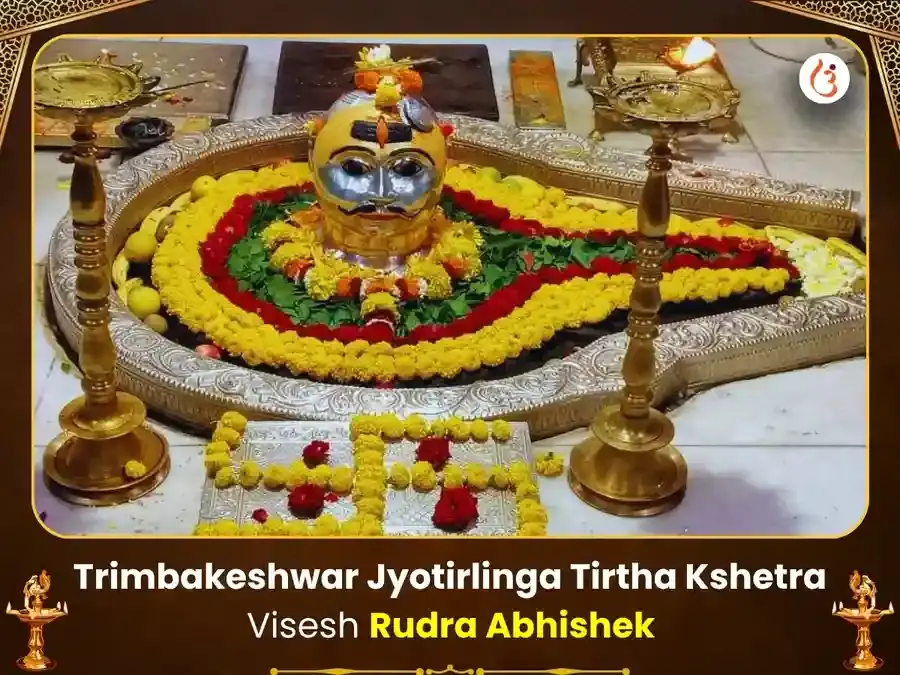Dwadash Jyotirlinga Stotram
Fri - Jun 21, 2024
4 min read
Share
The Dwadash Jyotirlinga Stotra is a sacred hymn of Hinduism in which the 12 Jyotirlingas of Lord Shiva are worshipped. By reciting this hymn according to the Shiv Puran, one receives the blessings of the 12 Jyotirlingas and gets freedom from sins. The stotra describes the location of all the Jyotirlingas of Shiva and their glory and by reciting it the devotee never has to fear death.
Table of Contents
1. Dwadasha Jyotirlinga Stotram
2. Meaning of Dwadash Jyotirlinga Stotram
3. Benefits of reciting Dwadasha Jyotirlinga Stotram

Dwadasha Jyotirlinga Stotram
Saurashtre Somanatham Cha Shrishaile Mallikarjunam |
Ujjaiyinyam Mahakaalam Omkarama-Maleshwaram |1||
Paralyam Vaidyanatham Cha Dakinyam Bheemashankaram |
Setubandhe Tu Ramesham Nagesham Darukavane |2||
Varanasyam Tu Vishvesham Tryambakam Gautamitate |
Himalaye Tu Kedaram Gushmesham Cha Shivalaye |3||
Atani Jyotirlingani Sayam Pratah Pathennarah |
Saptajanma Kritam Papam Smaranena Vinashyati |4||
Meaning of Dwadash Jyotirlinga Stotram
First line poetically describes the beauty and sanctity of Somnath in Saurashtra. It depicts Somnath as a divine, luminous figure descending gracefully to inspire devotion. The speaker expresses deep reverence. and wants to live under the shelter of this revered deity.
Second line describes a holy place on Sri Shaila, which is surrounded by deities, and another blissful peak called Tula Parvat. It mentions Arjuna, possibly an important deity, before Mallika, possibly Parvati. The speaker expresses deep reverence, bowing to a divine guide who guides life. helps to overcome the challenges of.
In the third line the devotee worships a divine incarnation in Avantika (Ujjain) who grants salvation to the virtuous and saves them from untimely death. The devotee worships this powerful deity, referred to as the great lord of demons, acknowledging its role in the protection and liberation of devotees.
Fourth line highlights the holy rivers Kaveri and Narmada and their role in saving the pious. It mentions the presence of Lord Shiva in the town of Mandhatri (Maheshwar), indicating the speaker's devotion to Shiva, particularly the Omkareshwar temple. The speaker worships only Shiva, recognizing his divine protection and purity.
Fifth line describes Sri Vaidyanatha, a revered deity, located in Prajwali Nidhi in the north-east, known for its mountains and eternal springs. Both gods (suras) and demons (asuras) worship his lotus feet. The speaker expresses profound respect and reverence for Sri Vaidyanatha, acknowledging his universal reverence and divine presence.
Sixth line describes Sri Naganatha, the deity of the southern city of Sadanga, who is known for his beauty and abundance of pleasures. This god grants devotion and liberation to his followers. The speaker seeks refuge in Sri Naganatha and asks for his divine blessings. Expresses deep faith and trust in the Lord.
Seventh part describes Lord Kedar (a form of Lord Shiva) who resides on the top of a big mountain. This deity is worshipped by great sages and revered by gods (suras), demons (asuras), yakshas and great serpents (mahoragas). The speaker expresses his devotion by worshipping Lord Kedar. We acknowledge His universal reverence and divine presence.
Eighth describes a sacred place on top of the Sahyadri Mountains and on the banks of the Godavari River. This emphasises that seeing this divine presence leads to instant destruction of sins. The speaker worships this deity, who is called the Lord of the Trinity, showing reverence for one form of the Hindu Trinity (Brahma, Vishnu, and Shiva), who is known to provide spiritual purification and liberation.
Ninth excerpt describes how Lord Rama (Sri Ramachandra) built a bridge (Ram Setu) over the ocean using countless arrows and other materials. This bridge was built with the help of his army led by Hanuman and is revered as a divine achievement. Lord Rama is honoured with the title of Rameswara, which reflects his role as a divine God in the epic Ramayana.
Tenth passage praises Lord Shiva, who is revered even among unconventional groups such as witches, sorcerers and carnivores. He is worshipped by Bhima and others., and is celebrated as a benefactor who supports and blesses his devotees.
Eleventh verse praises Lord Shiva, especially the Lord of Varanasi in the form of Sri Vishwanath. He is described as the source of bliss and the destroyer of sins. The speaker speaks of seeking refuge in Lord Shiva for spiritual peace and liberation.
Twelfth shloka is a prayer dedicated to Lord Shiva, specifically honouring him as Ghrishneshwara. It praises the divine qualities and generosity of Lord Shiva, as well as expressing complete surrender and seeking refuge in his name.
This shloka advises followers to worship the twelve Jyotirlingas (symbolic representations of Lord Shiva) sequentially with devotion. After reciting the hymns, devotees should
contemplate on the spiritual benefits received and then engage in self-worship or introspection.
Benefits of reciting Dwadasha Jyotirlinga Stotram
1. It destroys all the sins and troubles of the devotee and grants spiritual liberation (moksha).
2. Regular recitation of the stotra bestows the devotee with mental peace, good health, wealth and prosperity.
3. Reciting the stotra is believed to have the same spiritual effect as visiting the twelve Jyotirlinga temples of Lord Shiva.
4. The stotra is said to bring blessings from Lord Shiva as well as other deities like Mahalakshmi.
5. For maximum spiritual and material benefits, it is advisable to recite the stotra daily, especially in the morning and evening.
